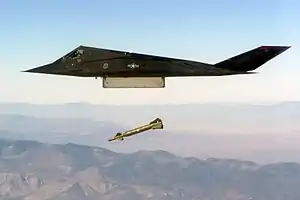Stealth aircraft
Stealth aircraft are designed to avoid detection using a variety of technologies that reduce reflection/emission of radar, infrared,[1] visible light, radio frequency (RF) spectrum, and audio, collectively known as stealth technology.[2] The F-117 Nighthawk was the first operational aircraft specifically designed around stealth technology. Other examples of stealth aircraft include the B-2 Spirit, the F-22 Raptor,[3] the F-35 Lightning II,[4] the Chengdu J-20,[5] and the Sukhoi Su-57.

While no aircraft is totally invisible to radar, stealth aircraft make it more difficult for conventional radar to detect or track the aircraft effectively, increasing the odds of an aircraft successfully avoiding detection by enemy radar and/or avoiding being successfully targeted by radar guided weapons. Stealth is the combination of passive low observable (LO) features and active emitters such as low-probability-of-intercept radars, radios and laser designators. These are usually combined with active measures such as carefully planning all mission maneuvers in order to minimize the aircraft's radar cross-section, since common actions such as hard turns or opening bomb bay doors can more than double an otherwise stealthy aircraft's radar return.[6] It is accomplished by using a complex design philosophy to reduce the ability of an opponent's sensors to detect, track, or attack the stealth aircraft.[7] This philosophy also takes into account the heat, sound, and other emissions of the aircraft as these can also be used to locate it. Sensors made to reduce the impact of current low observable technologies exist or have been proposed such as IRST (infrared search and track) systems to detect even reduced heat emissions,[8] long wavelength radars to counter stealth shaping and RAM focused on shorter wavelength radar,[9] or radar setups with multiple emitters to counter stealth shaping.[10] However these do so with disadvantages compared to traditional radar against non-stealthy aircraft.
Full-size stealth combat aircraft demonstrators have been flown by the United States (in 1977), Russia (in 2000) and China (in 2011).[11] As of December 2020, the only combat-ready stealth aircraft in service are the Northrop Grumman B-2 Spirit (1997), the Lockheed Martin F-22 Raptor (2005); the Lockheed Martin F-35 Lightning II (2015);,[12][13] the Chengdu J-20 (2017),[14] and the Sukhoi Su-57 (2020),[15] with a number of other countries developing their own designs. There are also various aircraft with reduced detectability, either unintentionally or as a secondary feature.
Background
World War I and World War II

During World War I, the Germans experimented with the use of Cellon (Cellulose acetate), a transparent covering material, in an attempt to reduce the visibility of military aircraft. Single examples of the Fokker E.III Eindecker fighter monoplane, the Albatros C.I two-seat observation biplane, and the Linke-Hofmann R.I prototype heavy bomber were covered with Cellon. However, it proved ineffective, and even counterproductive, as sunlight glinting from the covering made the aircraft even more visible. The material was also found to be quickly degraded both by sunlight and in-flight temperature changes, so the attempt to make transparent aircraft was not proceeded with.[16]
In 1916, the British modified a small SS class airship for the purpose of night-time aerial reconnaissance over German lines on the Western Front. Fitted with a silenced engine and a black gas bag, the craft was both invisible and inaudible from the ground, but several night-time flights over German-held territory produced little useful intelligence, and the idea was dropped.[17]
Nearly three decades later, the Horten Ho 229 flying wing fighter-bomber, developed in Nazi Germany during the last years of World War II. proved to have some stealth characteristics due to its lack of vertical surfaces (key characteristic of all stealth aircraft plus inherent feature of all flying wing aircraft like the Ho 229). Testing performed in 2008 by the Northrop-Grumman Corporation established that the aircraft's shape would have rendered the Ho 229 virtually invisible to the top-end HF-band, 20–30 MHz primary signals of Britain's Chain Home early warning radar, provided the aircraft was traveling at high speed (approximately 550 mph (890 km/h)) at extremely low altitude – 50–100 feet (15–30 m).[18] Despite that, the Ho 229 was never intended to be a stealth aircraft.[19]
Modern era
Modern stealth aircraft first became possible when Denys Overholser, a mathematician working for Lockheed Aircraft during the 1970s, adopted a mathematical model developed by Petr Ufimtsev, a Soviet scientist, to develop a computer program called Echo 1. Echo made it possible to predict the radar signature of an aircraft made with flat panels, called facets. In 1975, engineers at Lockheed Skunk Works found that an aircraft made with faceted surfaces could have a very low radar signature because the surfaces would radiate almost all of the radar energy away from the receiver. Lockheed built a model called "the Hopeless Diamond", a reference to the famous Hope Diamond and the design's predicted instability. Because advanced computers were available to control the flight of even the Hopeless Diamond, for the first time designers realized that it might be possible to make an aircraft that was virtually invisible to radar.[20][21]
Reduced radar cross section is only one of five factors the designers addressed to create a truly stealthy design such as the F-22. The F-22 has also been designed to disguise its infrared emissions to make it harder to detect by infrared homing ("heat seeking") surface-to-air or air-to-air missiles. Designers also addressed making the aircraft less visible to the naked eye, controlling radio transmissions, and noise abatement.[3]
The first combat use of purpose-designed stealth aircraft was in December 1989 during Operation Just Cause in Panama. On 20 December 1989, two United States Air Force F-117s bombed a Panamanian Defense Force barracks in Rio Hato, Panama. In 1991, F-117s were tasked with attacking the most heavily fortified targets in Iraq in the opening phase of Operation Desert Storm and were the only jets allowed to operate inside Baghdad's city limits.[22]
General design
The general design of a stealth aircraft is always aimed at reducing radar and thermal detection. It is the designer's top priority to satisfy the following conditions, which ultimately decide the success of the aircraft:-
- Reducing thermal emission from thrust
- Reducing radar detection by altering some general configuration (like introducing the split rudder)
- Reducing radar detection when the aircraft opens its weapons bay
- Reducing infra-red and radar detection during adverse weather conditions
Limitations

Instability of design
Early stealth aircraft were designed with a focus on minimal radar cross section (RCS) rather than aerodynamic performance. Highly stealth aircraft like the F-117 Nighthawk are aerodynamically unstable in all three axes and require constant flight corrections from a fly-by-wire (FBW) flight system to maintain controlled flight.[23] As for the B-2 Spirit, which was based on the development of the flying wing aircraft[24] by Jack Northrop in 1940, this design allowed for a stable aircraft with sufficient yaw control, even without vertical surfaces such as rudders.
Aerodynamic limitations
Earlier stealth aircraft (such as the F-117 and B-2) lack afterburners, because the hot exhaust would increase their infrared footprint, and flying faster than the speed of sound would produce an obvious sonic boom, as well as surface heating of the aircraft skin, which also increases the infrared footprint. As a result, their performance in air combat maneuvering required in a dogfight would never match that of a dedicated fighter aircraft. This was unimportant in the case of these two aircraft since both were designed to be bombers. More recent design techniques allow for stealthy designs such as the F-22 without compromising aerodynamic performance. Newer stealth aircraft, like the F-22, F-35 and the Su-57, have performance characteristics that meet or exceed those of current front-line jet fighters due to advances in other technologies such as flight control systems, engines, airframe construction and materials.[3][25]
Electromagnetic emissions
The high level of computerization and large amount of electronic equipment found inside stealth aircraft are often claimed to make them vulnerable to passive detection. This is highly unlikely and certainly systems such as Tamara and Kolchuga, which are often described as counter-stealth radars, are not designed to detect stray electromagnetic fields of this type. Such systems are designed to detect intentional, higher power emissions such as radar and communication signals. Stealth aircraft are deliberately operated to avoid or reduce such emissions.
Current Radar Warning Receivers look for the regular pings of energy from mechanically swept radars while fifth generation jet fighters use Low Probability of Intercept Radars with no regular repeat pattern.[26]
Vulnerable modes of flight
Stealth aircraft are still vulnerable to detection during and immediately after using their weaponry. Since stealth payload (reduced RCS bombs and cruise missiles) is not yet generally available, and ordnance mount points create a significant radar return, stealth aircraft carry all armaments internally. As soon as weapons bay doors are opened, the plane's RCS will be multiplied and even older generation radar systems will be able to locate the stealth aircraft. While the aircraft will reacquire its stealth as soon as the bay doors are closed, a fast response defensive weapons system has a short opportunity to engage the aircraft.
This vulnerability is addressed by operating in a manner that reduces the risk and consequences of temporary acquisition. The B-2's operational altitude imposes a flight time for defensive weapons that makes it virtually impossible to engage the aircraft during its weapons deployment. New stealth aircraft designs such as the F-22 and F-35 can open their bays, release munitions and return to stealthy flight in less than a second.
Some weapons require that the weapon's guidance system acquire the target while the weapon is still attached to the aircraft. This forces relatively extended operations with the bay doors open.
Such aircraft as the F-22 Raptor and F-35 Lightning II Joint Strike Fighter can also carry additional weapons and fuel on hardpoints below their wings. When operating in this mode the planes will not be nearly as stealthy, as the hardpoints and the weapons mounted on those hardpoints will show up on radar systems. This option therefore represents a trade off between stealth or range and payload. External stores allow those aircraft to attack more targets further away, but will not allow for stealth during that mission as compared to a shorter range mission flying on just internal fuel and using only the more limited space of the internal weapon bays for armaments.
Reduced payload

Fully stealth aircraft carry all fuel and armament internally, which limits the payload. By way of comparison, the F-117 carries only two laser- or GPS-guided bombs, while a non-stealth attack aircraft can carry several times more. This requires the deployment of additional aircraft to engage targets that would normally require a single non-stealth attack aircraft. This apparent disadvantage however is offset by the reduction in fewer supporting aircraft that are required to provide air cover, air-defense suppression and electronic counter measures, making stealth aircraft "force multipliers".
Sensitive skin
Stealth aircraft often have skins made with radiation-absorbent materials or RAMs. Some of these contain carbon black particles, some contain tiny iron spheres. There are many materials used in RAMs, and some are classified, particularly the materials that specific aircraft use.[27]
Cost of operations
Stealth aircraft are typically more expensive to develop and manufacture. An example is the B-2 Spirit that is many times more expensive to manufacture and support than conventional bomber aircraft. The B-2 program cost the U.S. Air Force almost $45 billion.[28]
Countermeasures
Reflected waves
Passive (multistatic) radar, bistatic radar[29] and especially multistatic radar systems detect some stealth aircraft better than conventional monostatic radars, since first-generation stealth technology (such as the F117) reflects energy away from the transmitter's line of sight, effectively increasing the radar cross section (RCS) in other directions, which the passive radars monitor. Such a system typically uses either low frequency broadcast TV and FM radio signals (at which frequencies controlling the aircraft's signature is more difficult).
Researchers at the University of Illinois at Urbana–Champaign with support of DARPA, have shown that it is possible to build a synthetic aperture radar image of an aircraft target using passive multistatic radar, possibly detailed enough to enable automatic target recognition.[30]
In December 2007, SAAB researchers revealed details for a system called Associative Aperture Synthesis Radar (AASR) that would employ a large array of inexpensive and redundant transmitters and receivers that could detect targets when they directly pass between the receivers/transmitters and create a shadow.[31] The system was originally designed to detect stealthy cruise missiles and should be just as effective against low-flying stealth aircraft. That the array could contain a large amount of inexpensive equipment could potentially offer some "protection" against attacks by expensive anti-radar (or anti-radiation) missiles.
Infrared (heat)
Some analysts claim Infra-red search and track systems (IRSTs) can be deployed against stealth aircraft, because any aircraft surface heats up due to air friction and with a two channel IRST is a CO2 (4.3 µm absorption maxima) detection possible, through difference comparing between the low and high channel.[32][33] These analysts point to the resurgence in such systems in Russian designs in the 1980s, such as those fitted to the MiG-29 and Su-27. The latest version of the MiG-29, the MiG-35, is equipped with a new Optical Locator System that includes more advanced IRST capabilities. The French Rafale, the British/German/Italian/Spanish Eurofighter and the Swedish Gripen also make extensive use of IRST.
In air combat, the optronic suite allows:
- Detection of non-afterburning targets at 45 kilometres (28 mi) range and more;
- Identification of those targets at 8-to-10-kilometre (5.0 to 6.2 mi) range; and
- Estimates of aerial target range at up to 15 kilometres (9.3 mi).
For ground targets, the suite allows:
- A tank-effective detection range up to 15 kilometres (9.3 mi), and aircraft carrier detection at 60 to 80 kilometres (37 to 50 mi);
- Identification of the tank type on the 8-to-10-kilometre (5.0 to 6.2 mi) range, and of an aircraft carrier at 40 to 60 kilometres (25 to 37 mi); and
- Estimates of ground target range of up to 20 kilometres (12 mi).
Longer wavelength radar
VHF radar systems have wavelengths comparable to aircraft feature sizes and should exhibit scattering in the resonance region rather than the optical region, allowing most stealth aircraft to be detected. This has prompted Nizhny Novgorod Research Institute of Radio Engineering (NNIIRT) to develop VHF AESAs such as the NEBO SVU, which is capable of performing target acquisition for Surface-to-air missile batteries. Despite the advantages offered by VHF radar, their longer wavelengths result in poor resolution compared to comparably sized X band radar array. As a result, these systems must be very large before they can have the resolution for an engagement radar. An example of a ground-based VHF radar with counter-stealth capability is the P-18 radar.
The Dutch company Thales Nederland, formerly known as Holland Signaal, developed a naval phased-array radar called SMART-L, which is operated at L Band and has counter-stealth. All ships of the Royal Dutch Navy's De Zeven Provinciën class carry, among others, the SMART-L radar.
OTH radar (over-the-horizon radar)
Over-the-horizon radar is a concept increasing radar's effective range over conventional radar. The Australian JORN Jindalee Operational Radar Network can overcome certain stealth characteristics.[34] It is claimed that the HF frequency used and the method of bouncing radar from ionosphere overcomes the stealth characteristics of the F-117A. In other words, stealth aircraft are optimized for defeating much higher-frequency radar from front-on rather than low-frequency radars from above.
Operational usage of stealth aircraft






_at_the_2014_Zhuhai_Air_Show.jpg.webp)
The U.S. and Israel are the only countries to have used stealth aircraft in combat.[35][36] These deployments include the United States invasion of Panama, the first Gulf War, the Kosovo Conflict, the War in Afghanistan, the War in Iraq and the 2011 military intervention in Libya. The first use of stealth aircraft was in the U.S. invasion of Panama, where F-117 Nighthawk stealth attack aircraft were used to drop bombs on enemy airfields and positions while evading enemy radar.[37]
In 1990 the F-117 Nighthawk was used in the First Gulf War, where F-117s flew 1,300 sorties and scored direct hits on 1,600 high-value targets in Iraq[38] while accumulating 6,905 flight hours.[39] Only 2.5% of the American aircraft in Iraq were F-117s, yet they struck 40% of the strategic targets, dropping 2,000 tons of precision-guided munitions and striking their targets with an 80% success rate.[39]
In the 1999 NATO bombing of Yugoslavia two stealth aircraft were used by the United States, the veteran F-117 Nighthawk, and the newly introduced B-2 Spirit strategic stealth bomber. The F-117 performed its usual role of striking precision high-value targets and performed well, although one F-117 was shot down by a Serbian Isayev S-125 'Neva-M' missile commanded by Colonel Zoltán Dani. The then-new B-2 Spirit was highly successful, destroying 33% of selected Serbian bombing targets in the first eight weeks of U.S. involvement in the War. During this war, B-2s flew non-stop to Kosovo from their home base in Missouri and back.[41]
In the 2003 invasion of Iraq, F-117 Nighthawks and B-2 Spirits were used, and this was the last time the F-117 would see combat. F-117s dropped satellite-guided strike munitions on selected targets, with high success. B-2 Spirits conducted 49 sorties in the invasion, releasing 1.5 million pounds of munitions.[41]
During the May 2011 operation to kill Osama bin Laden, one of the helicopters used to clandestinely insert U.S. troops into Pakistan crashed in the bin Laden compound. From the wreckage it was revealed this helicopter had stealth characteristics, making this the first publicly known operational use of a stealth helicopter.
Stealth aircraft were used in the 2011 military intervention in Libya, where B-2 Spirits dropped 40 bombs on a Libyan airfield with concentrated air defenses in support of the UN no-fly zone.[42]
Stealth aircraft will continue to play a valuable role in air combat with the United States using the F-22 Raptor, B-2 Spirit, and the F-35 Lightning II to perform a variety of operations. The F-22 made its combat debut over Syria in September 2014 as part of the US-led coalition to defeat ISIS.
From February 2018, Su-57s performed the first international flight as they were spotted landing at the Russian Khmeimim air base in Syria. These Su-57s were deployed along with four Sukhoi Su-35 fighters, four Sukhoi Su-25s, and one Beriev A-50 AEW&C aircraft.[43] It is believed that at least 4 Su-57 are deployed in Syria.[44] and that they have likely been armed with cruise missiles in combat [45]
In 2018, a report surfaced noting that Israeli F-35I stealth fighters conducted a number of missions in Syria and even infiltrated Iranian airspace without detection.[35] In May 2018, Major General Amikam Norkin of IAF reported that Israeli Air Force F-35I stealth fighters carried out the first-ever F-35 strike in combat over Syria.[36]
The People's Republic of China started flight testing its Chengdu J-20 stealth multirole fighter around in 2011 and made its first public appearance at Airshow China 2016. The aircraft entered service with the People's Liberation Army Air Force (PLAAF) in March 2017.[46][47][48] Another fifth-generation stealth multirole fighter from China, the Shenyang FC-31 is also under flight testing.[49]
List of stealth aircraft
Dedicated reduced cross section designs
- In service
 B-2 Spirit – Northrop Grumman
B-2 Spirit – Northrop Grumman F-22 Raptor – Lockheed Martin
F-22 Raptor – Lockheed Martin F-35 Lightning II – Lockheed Martin
F-35 Lightning II – Lockheed Martin J-20 – Chengdu Aircraft Corporation
J-20 – Chengdu Aircraft Corporation Sukhoi Su-57 – Sukhoi
Sukhoi Su-57 – Sukhoi
- Retired
 A-12 – Lockheed Corporation
A-12 – Lockheed Corporation F-117 Nighthawk – Lockheed Corporation
F-117 Nighthawk – Lockheed Corporation SR-71 Blackbird – Lockheed Corporation
SR-71 Blackbird – Lockheed Corporation
- In the testing phase
 JH-XX – Shenyang Aircraft Corporation – (Supersonic medium-range strike bomber to replace the JH-7.)
JH-XX – Shenyang Aircraft Corporation – (Supersonic medium-range strike bomber to replace the JH-7.) FC-31 – Shenyang Aircraft Corporation
FC-31 – Shenyang Aircraft Corporation
- In the project
 High-speed stealth Kamov – Kamov
High-speed stealth Kamov – Kamov MiG-41[50][51] – Mikoyan.
MiG-41[50][51] – Mikoyan. MiG LMFS – Mikoyan
MiG LMFS – Mikoyan PAK DA – Tupolev
PAK DA – Tupolev PAK ShA – Sukhoi – (Upcoming ground attack aircraft with stealth features)[52]
PAK ShA – Sukhoi – (Upcoming ground attack aircraft with stealth features)[52] F/A-XX
F/A-XX F-X / Penetrating Counter Air/ Next Generation Air Dominance
F-X / Penetrating Counter Air/ Next Generation Air Dominance B-21 Raider – Northrop Grumman
B-21 Raider – Northrop Grumman H-20 – Xi'an Aircraft Industrial Corporation
H-20 – Xi'an Aircraft Industrial Corporation Shenyang "JJ"[53] – Shenyang Aircraft Corporation
Shenyang "JJ"[53] – Shenyang Aircraft Corporation Advanced Defense Stealth Fighter[54] – Industrial Technology Research Institute
Advanced Defense Stealth Fighter[54] – Industrial Technology Research Institute AMCA – ADA / HAL
AMCA – ADA / HAL

 – BAE Systems Tempest – BAE Systems
– BAE Systems Tempest – BAE Systems Flygsystem 2020 – Saab
Flygsystem 2020 – Saab F-X
F-X HESA Shafaq – HESA / IAMI
HESA Shafaq – HESA / IAMI
 KAI KF-X – Korea Aerospace Industries / Indonesian Aerospace
KAI KF-X – Korea Aerospace Industries / Indonesian Aerospace

 – New Generation Fighter – (Typhoon/Rafale replacement by Dassault Aviation and Airbus Defense and Space)
– New Generation Fighter – (Typhoon/Rafale replacement by Dassault Aviation and Airbus Defense and Space) Project-AZM – Pakistan Aeronautical Complex
Project-AZM – Pakistan Aeronautical Complex TAI TFX – Turkish Aerospace Industries
TAI TFX – Turkish Aerospace Industries
- Canceled
 A-12 Avenger II – McDonnell-Douglas / General Dynamics
A-12 Avenger II – McDonnell-Douglas / General Dynamics Boeing Model 853 Quiet Bird
Boeing Model 853 Quiet Bird Convair Kingfish
Convair Kingfish Lockheed Martin FB-22
Lockheed Martin FB-22 Lockheed Martin X-44 MANTA
Lockheed Martin X-44 MANTA Lockheed Senior Peg – (The Lockheed proposal for the Advanced Technology Bomber)
Lockheed Senior Peg – (The Lockheed proposal for the Advanced Technology Bomber) RAH-66 Comanche – Boeing Sikorsky
RAH-66 Comanche – Boeing Sikorsky Mikoyan MiG 4.12[55] – (Proposed smaller and single engine variant of the MiG 1.44)
Mikoyan MiG 4.12[55] – (Proposed smaller and single engine variant of the MiG 1.44) Tupolev Tu-202[56] – (Flying wing stealth bomber intended for surface attack and anti-submarine warfare, abandoned with the end of the cold War)
Tupolev Tu-202[56] – (Flying wing stealth bomber intended for surface attack and anti-submarine warfare, abandoned with the end of the cold War) Yakovlev Yak-201.[57] – (Fifth-generation VTOL aircraft intended for the Russian Navy in the 1990s)
Yakovlev Yak-201.[57] – (Fifth-generation VTOL aircraft intended for the Russian Navy in the 1990s)
 Sukhoi/HAL FGFA
Sukhoi/HAL FGFA Myasishchev M-67 LK-M[58][59] – (Flying wing stealth bomber or high-altitude surveillance plane proposed by Myasishchev)
Myasishchev M-67 LK-M[58][59] – (Flying wing stealth bomber or high-altitude surveillance plane proposed by Myasishchev) Sukhoi T-4MS[60] – (Stealth bomber concept to compete with the American B-1 Lancer)
Sukhoi T-4MS[60] – (Stealth bomber concept to compete with the American B-1 Lancer) Sukhoi T-60S[61] – (Canceled project to replace the Tu-22 bomber; the T-60S was supposed to have a low-profile design in order to be stealthy)
Sukhoi T-60S[61] – (Canceled project to replace the Tu-22 bomber; the T-60S was supposed to have a low-profile design in order to be stealthy) BAE P.1214 Harrier 2– BAE Systems
BAE P.1214 Harrier 2– BAE Systems BAE Systems Replica – BAE Systems
BAE Systems Replica – BAE Systems Future Offensive Air System – BAE Systems
Future Offensive Air System – BAE Systems EADS Mako/HEAT
EADS Mako/HEAT i3 fighter[62]
i3 fighter[62] MBB Lampyridae[63] – (West German stealth fighter prototype)
MBB Lampyridae[63] – (West German stealth fighter prototype) FMA SAIA 90 – (Multirole fighter)
FMA SAIA 90 – (Multirole fighter).svg.png.webp) Horten H.XVIIIA[64] – Horten brothers
Horten H.XVIIIA[64] – Horten brothers.svg.png.webp) Novi Avion – (Yugoslav prototype, designed to have a features to lower its RADAR cross section)
Novi Avion – (Yugoslav prototype, designed to have a features to lower its RADAR cross section)
- Technology demonstrators
 Boeing Bird of Prey – Boeing
Boeing Bird of Prey – Boeing Have Blue – Lockheed
Have Blue – Lockheed McDonnell Douglas X-36 – McDonnell Douglas
McDonnell Douglas X-36 – McDonnell Douglas Northrop Tacit Blue – Northrop
Northrop Tacit Blue – Northrop Northrop XST – Northrop – (Stealth technology demonstrator)
Northrop XST – Northrop – (Stealth technology demonstrator) Windecker YE-5 – Windecker
Windecker YE-5 – Windecker YF-22 – Northrop / Boeing / General Dynamics – (Developed into F-22 Raptor)
YF-22 – Northrop / Boeing / General Dynamics – (Developed into F-22 Raptor) YF-23 Black Widow II – (Northrop / McDonnell Douglas prototype)
YF-23 Black Widow II – (Northrop / McDonnell Douglas prototype) X-35 – Lockheed Martin – JSF (Winning contender developed into F-35 Lightning II)
X-35 – Lockheed Martin – JSF (Winning contender developed into F-35 Lightning II) X-32 – Boeing – JSF (Losing contender)
X-32 – Boeing – JSF (Losing contender) MiG 1.44 – Mikoyan (Russian 5th generation fighter prototype)
MiG 1.44 – Mikoyan (Russian 5th generation fighter prototype) Sukhoi Su-47 – Sukhoi – (Russian technology demonstrator)
Sukhoi Su-47 – Sukhoi – (Russian technology demonstrator) Sukhoi T-50 – Sukhoi – (Prototype versions of the Su-57)
Sukhoi T-50 – Sukhoi – (Prototype versions of the Su-57) Mitsubishi X-2 – Mitsubishi Heavy Industries
Mitsubishi X-2 – Mitsubishi Heavy Industries
Accidental or secondary function reduced cross section designs
 B-1B Lancer – (RCS to about 1.0 m2 [65])
B-1B Lancer – (RCS to about 1.0 m2 [65]) Boeing F-15SE Silent Eagle[66]
Boeing F-15SE Silent Eagle[66] F-16C/D and E/F Fighting Falcon – (From Block 30 has got reduced RCS to about 1.2m2[65])
F-16C/D and E/F Fighting Falcon – (From Block 30 has got reduced RCS to about 1.2m2[65]) F/A-18E/F Super Hornet – (The F/A-18E/F's radar cross section was reduced greatly from some aspects, mainly the front and rear. RCS to about 20 dB lower as a F18 C/D[67])
F/A-18E/F Super Hornet – (The F/A-18E/F's radar cross section was reduced greatly from some aspects, mainly the front and rear. RCS to about 20 dB lower as a F18 C/D[67]) Northrop YB-49[68]
Northrop YB-49[68] Scaled Composites 401 – Obvious stealth shaping plus composite materials
Scaled Composites 401 – Obvious stealth shaping plus composite materials Mikoyan MiG-29K – (Use low-observable technology, such as radar-absorbent materials and a turbofan engine engineered to decrease infrared signature, which reduce the MiG-29K's radar signature 4–5 times over the basic MiG-29.[69][70]
Mikoyan MiG-29K – (Use low-observable technology, such as radar-absorbent materials and a turbofan engine engineered to decrease infrared signature, which reduce the MiG-29K's radar signature 4–5 times over the basic MiG-29.[69][70] Sukhoi Su-35 – (Radar absorbent material on the engine inlets and compressor to halve its RCS)[71]
Sukhoi Su-35 – (Radar absorbent material on the engine inlets and compressor to halve its RCS)[71] Tupolev Tu-160M2 – (Equipped with radar absorbent coatings)[72][73][74]
Tupolev Tu-160M2 – (Equipped with radar absorbent coatings)[72][73][74].svg.png.webp) Messerschmitt Me 163B – (Rocket-powered point defense interceptor aircraft)[75]
Messerschmitt Me 163B – (Rocket-powered point defense interceptor aircraft)[75].svg.png.webp) Horten Ho 229 – (Flying wing design and partially buried engines may have given a low RCS) [76][77][78][79][80][81][16]
Horten Ho 229 – (Flying wing design and partially buried engines may have given a low RCS) [76][77][78][79][80][81][16] Dassault Rafale – (RCS to about 0.20–0.75 m2)[65]
Dassault Rafale – (RCS to about 0.20–0.75 m2)[65]


 Eurofighter Typhoon – (RCS to about 0.25–0.75 m2)[65]
Eurofighter Typhoon – (RCS to about 0.25–0.75 m2)[65] Mitsubishi F-2– (Composite materials for reduced RCS)[82]
Mitsubishi F-2– (Composite materials for reduced RCS)[82]
Unmanned reduced RCS designs
 Boeing MQ-25 Stingray[83]
Boeing MQ-25 Stingray[83] Boeing X-45
Boeing X-45 Fifth Generation Aerial Target[84] – Fighter-sized stealth target drone
Fifth Generation Aerial Target[84] – Fighter-sized stealth target drone General Atomics Avenger
General Atomics Avenger General Atomics "Ultra-long endurance" stealth ISR UCAV[85]
General Atomics "Ultra-long endurance" stealth ISR UCAV[85] Kratos XQ-58 Valkyrie[86] – (Trapezoidal fuselage with a chined edge, V-tails, and an S-shaped air intake)
Kratos XQ-58 Valkyrie[86] – (Trapezoidal fuselage with a chined edge, V-tails, and an S-shaped air intake) LoFLYTE (Low Observable Flight Test Experiment)[87]
LoFLYTE (Low Observable Flight Test Experiment)[87] Lockheed Martin Minion (RCS smaller than F-22 or F-35)
Lockheed Martin Minion (RCS smaller than F-22 or F-35) Lockheed Martin Polecat
Lockheed Martin Polecat Lockheed Martin RQ-170 Sentinel
Lockheed Martin RQ-170 Sentinel Lockheed Martin X-44 (UAV)
Lockheed Martin X-44 (UAV) Northrop Grumman RQ-180
Northrop Grumman RQ-180 Northrop Grumman X-47A – (Technology demonstrator)
Northrop Grumman X-47A – (Technology demonstrator) Northrop Grumman X-47B – (Technology demonstrator)
Northrop Grumman X-47B – (Technology demonstrator) Ryan AQM-91 Firefly – (Engine on top of fuselage, fuselage with radar absorbent material, flat bottom and sloped sides, canted vertical stabilizers to conceal the exhaust stream)
Ryan AQM-91 Firefly – (Engine on top of fuselage, fuselage with radar absorbent material, flat bottom and sloped sides, canted vertical stabilizers to conceal the exhaust stream) Ryan Model 147H – (Various RCS reduction measures)
Ryan Model 147H – (Various RCS reduction measures) CASC CH-7 – (Obvious stealth shaping)
CASC CH-7 – (Obvious stealth shaping) CH-805 [89][90] – (Flying wing target drone, RCS of 0.01 square meters, for simulating stealth aircraft)
CH-805 [89][90] – (Flying wing target drone, RCS of 0.01 square meters, for simulating stealth aircraft) CK-20[90][91]
CK-20[90][91] CASIC Sky Hawk – (Tian Ying Flying wing version)
CASIC Sky Hawk – (Tian Ying Flying wing version) FL-71
FL-71 LJ-1[92] – (Sealth target drone, RCS similar to a F-35 Lightning II)
LJ-1[92] – (Sealth target drone, RCS similar to a F-35 Lightning II) Sharp Sword
Sharp Sword Star UAV System Star Shadow
Star UAV System Star Shadow Wind Blade
Wind Blade Eleron-3SV[93] – (Low-observable flying wing tactical UAV with silent electric engine)
Eleron-3SV[93] – (Low-observable flying wing tactical UAV with silent electric engine) Kronshtadt Thunder ("Grom")[94]
Kronshtadt Thunder ("Grom")[94] MiG Skat[95]
MiG Skat[95] Myasishchev Obzor-1[96] (High-altitude attack drone with stealth technology)
Myasishchev Obzor-1[96] (High-altitude attack drone with stealth technology) Simonov unnamed strike drone[97] – (ISR UCAV with a stealthy design similar to the General Atomics Avenger)
Simonov unnamed strike drone[97] – (ISR UCAV with a stealthy design similar to the General Atomics Avenger) Sukhoi Okhotnik[98] – (Heavy stealth UCAV).
Sukhoi Okhotnik[98] – (Heavy stealth UCAV). BAE Systems Corax – (Stealth UAV prototype)
BAE Systems Corax – (Stealth UAV prototype) BAE Systems Magma – (Flapless drone prototype)[99]
BAE Systems Magma – (Flapless drone prototype)[99] BAE Systems Taranis – (UCAV Technology Demonstrator)
BAE Systems Taranis – (UCAV Technology Demonstrator) Dassault nEUROn – (Technology demonstrator)
Dassault nEUROn – (Technology demonstrator) Dassault Moyen Duc – (Experimental UAV)
Dassault Moyen Duc – (Experimental UAV) Dassault Petit Duc – (Experimental UAV)
Dassault Petit Duc – (Experimental UAV) Sagitta Research Demonstrator – Airbus – (Technology demonstrator)[100]
Sagitta Research Demonstrator – Airbus – (Technology demonstrator)[100]
 EADS Barracuda[67] – EADS – (Technology demonstrator)
EADS Barracuda[67] – EADS – (Technology demonstrator) Rheinmetall KZO[101] – Rheinmetall – (Tactical UAV with stealthy features)
Rheinmetall KZO[101] – Rheinmetall – (Tactical UAV with stealthy features) Shahed 171 Simorgh
Shahed 171 Simorgh Sofreh Mahi[102] – IAMI – (UCAV)
Sofreh Mahi[102] – IAMI – (UCAV) Saab FILUR[103] – (Flying Innovative Low-observable Unmanned Research)
Saab FILUR[103] – (Flying Innovative Low-observable Unmanned Research) Saab SHARC
Saab SHARC Saqr
Saqr Armstechno NITI – (Tactical UAV)
Armstechno NITI – (Tactical UAV).svg.png.webp) Boeing Australia Airpower Teaming System[104]
Boeing Australia Airpower Teaming System[104] DRDO Ghatak
DRDO Ghatak IAI Harop – (Loitering munition designed to minimize its radar-signature)
IAI Harop – (Loitering munition designed to minimize its radar-signature) Korea Aerospace Industries K-X UCAV[105] – (Obvious stealth shaping flying wing)
Korea Aerospace Industries K-X UCAV[105] – (Obvious stealth shaping flying wing)
See also
References
- Mahulikar, S.P., Sonawane, H.R., & Rao, G.A.: (2007) "Infrared signature studies of aerospace vehicles", Progress in Aerospace Sciences, v. 43(7–8): 218–245.
- Rao, G.A., & Mahulikar, S.P.: (2002) "Integrated review of stealth technology and its role in airpower", Aeronautical Journal, v. 106(1066): 629–641.
- John Pike (21 January 2008). "Global Security.org F-22". Globalsecurity.org. Retrieved 16 December 2010.
- Global Security.org F-35.
- "Does China's J-20 rival other stealth fighters?".
- Radar versus Stealth: Passive Radar and the Future of U.S. Military Power Archived 20 September 2009 at the Wayback Machine
- "FAS.org". FAS.org. Retrieved 16 December 2010.
- Rogoway, Tyler. "Infrared Search And Track Systems And The Future Of The US Fighter Force". Foxtrot Alpha. Retrieved 7 March 2019.
- Axe, David (12 July 2016). "Did Russia's New Radar Just Make America's Lethal Stealth Fighters Obsolete?". The National Interest. Retrieved 7 March 2019.
- Tao Yue (30 November 2001). "Scouting For Surveillance: Detection of the B-2 Stealth Bomber And a Brief History on 'Stealth'". The Tech. Retrieved 7 March 2019.
- Robinson, Tim. "Not so hidden dragon – China's J-20 assessed". Archived 11 February 2011 at the Wayback Machine Aerospace Insight, 14 January 2011.
- "5th Generation Fighters". Lockheed Martin. Archived from the original on 9 January 2010. Retrieved 15 April 2009.
- "Marines Declare F-35B Operational, But Is It Really Ready For Combat?". Foxtrot Alpha. Archived from the original on 4 March 2018. Retrieved 4 March 2018.
- "With the J20 stealth fighter in fully operation service, China leaps ahead in Asian arms race". Australian News. 20 October 2017. Archived from the original on 26 February 2018. Retrieved 4 March 2018.
- https://tass.ru/armiya-i-opk/10352497
- Haddow, G.W.; Peter M. Grosz (1988). The German Giants – The German R-Planes 1914–1918 (3rd ed.). London: Putnam. ISBN 0-85177-812-7.
- Abbott, Patrick (1989). The British Airship at War, 1914–1918. Terence Dalton. pp. 31–33. ISBN 0861380738.
- Myhra, David (July 2009). "Northrop Tests Hitler's 'Stealth' Fighter". Aviation History. 19 (6): 11.
- "Is It Stealthy? | National Air and Space Museum". airandspace.si.edu. Retrieved 3 December 2020.
- "Centennial of Flight". centennialofflight.net. Retrieved 16 December 2010.
- See Rich and Janos, Skunk Works; Little Brown & Co., 1994 passim chapters 1 and 2.
- John Pike. "Global Security.org F-117". Globalsecurity.org. Retrieved 16 December 2010.
- Rich and Janos, Skunk Works, pgs 30–31, 46.
- Ford, Daniel (July 2019). "Jack Northrop: The Development of All-Wing Aircraft". The Warbird's Forum. An abridged version of the 35th Wilbur Wright Memorial Lecture, which Jack Northrop read to the Royal Aeronautical Society on May 29, 1947.
- John Pike (26 October 2001). "Global Security.org F-35". Globalsecurity.org. Retrieved 16 December 2010.
- "Raptor … or Turkey?". Defensetech.org. 14 August 2006. Retrieved 16 December 2010.
- Weiner, Tim (23 August 1997). "The $2 Billion Stealth Bomber Can't Go Out in the Rain". The New York Times. Retrieved 18 December 2007.
- United States General Accounting Office (GAO) B-2 Bomber: Cost and Operational Issues (Letter Report, 08/14/97, GAO/NSIAD-97-181) Archived 8 April 2015 at the Wayback Machine
- "Bistatic Radar Sets". Radartutorial.eu. Retrieved 16 December 2010.
- ATR. DARPA
- "Radical and Cheap Anti-Stealth Radar". 7 December 2007.
- "RAND Report Page 37". Flight International. Retrieved 16 December 2010.
- "VI – Stealth Aircraft: Eagles Among Sparrows?". Federation of American Scientists. Retrieved 21 February 2008.
- "de beste bron van informatie over Aerospace. Deze website is te koop!". defence-data.com. Archived from the original on 26 July 2010. Retrieved 16 December 2010.
- "Report: Israeli stealth fighters fly over Iran". The Jerusalem Post. Retrieved 24 July 2019.
- "Israel Launched World's First Air Strike Using F-35 Stealth Fighters, Air Force Chief Says". Haaretz. 24 May 2018. Retrieved 24 July 2019.
- Crocker 2006, p. 382.
- "Lockheed F-117A Nighthawk".
- "Weapons - F-117a Stealth". Frontline. WGBH.
- Factsheets : B-2 Spirit Archived 21 July 2012 at Archive.today
- "Crisis in Libya: U.S. bombs Qaddafi's airfields". CBS News. 19 March 2011.
- "Alleged PHOTO, VIDEO of Russian Su-57 Fifth Gen Jet in Syria Released on Twitter". Sputnik (news agency). 22 February 2018.
- https://thediplomat.com/2020/02/report-russia-has-developed-prototype-of-air-to-ground-hypersonic-missile-for-su-57/
- "Alert 5 » Su-57 launched cruise missile while deployed to Syria". Military Aviation News. alert5.com.
- "中国空军副司令首曝:国产第四代战机即将首飞" [Chinese Air Force deputy commander on first exposure: Domestic upcoming fourth-generation fighter first flight]. Phoenix Television News (in Chinese). 9 November 2009. Archived from the original on 12 November 2009.
- [面对面]何为荣:剑啸长空 [[Face to face] He Weirong: Swordsman of the sky] (in Chinese). CCTV. 8 November 2011. Archived from the original on 26 January 2010.
- "编号78272:第二架五位数编号歼-20曝光 部署沧州". news.ifeng.com. 12 December 2016.
- Lin, Jeffrey; Singer, P. W. (3 February 2016). "China Stays Ahead in Asian Stealth Race". Popular Science. Retrieved 16 July 2016.
- Peck, Michael (2 September 2017). "Russia Says Its MiG-41 Fighter Will Fly in Outer Space". The National Interest. Retrieved 29 December 2018.
- "МиГ-41: на что будет способен российский супер-истребитель 6-го поколения". russian7.ru. Retrieved 29 December 2018.
- https://www.flightglobal.com/russian-air-force-to-order-su-25-replacement/105426.article
- https://www.meta-defense.fr/2019/12/16/le-constructeur-chinois-shenyang-developpe-un-nouveau-chasseur-furtif/
- "Taiwan to develop new stealth fighter jets, ministry says". Taipei Times.
- airvectors.net/avruff.html
- "Plano Brasil – PAK DA o novo bombardeiro estratégico Russo". planobrazil.com. Retrieved 29 December 2018.
- https://www.globalsecurity.org/military/world/russia/yak-201.htm
- Rose, Bill; Secret Projects: Flying Wings and Tailless Aircraft. Hinckley, UK: Midland Publishing, 2010. ISBN 978-1-85780-320-4.
- http://www.ussr-airspace.com/index.php?main_page=document_general_info&cPath=28_39_38_108&products_id=1230
- "T-4MS ("200") strategic bombwer". testpilot.ru. Retrieved 17 January 2019.
- "Т-60С". testpilot.ru. Retrieved 17 January 2019.
- https://thediplomat.com/2020/02/what-is-japans-next-generation-fighter-concept-about/
- "Lampyridae". F-104.de. 14 March 1995. Retrieved 16 December 2010.
- Myhra, David. The Horten Brothers and Their All-Wing Aircraft. Atglen PA: Schiffer Publishing Ltd., 1998. ISBN 0-7643-0441-0.
- "Situation Awareness". Users.globalnet.co.uk. Retrieved 16 December 2010.
- https://nationalinterest.org/blog/buzz/stealthy-f-15-%E2%80%98silent-eagle%E2%80%99-smart-idea-or-waste-money-29127
- "EADS Knows LO, Aviationweek May 23, 2007". Aviationweek.typepad.com. 23 May 2007. Retrieved 16 December 2010.
- "Northrop YB-49, YRB-49 Strategic Bomber Prototype, Reconnaissance Prototype". Aerospaceweb.org – Aircraft Museum. Retrieved 17 January 2019.
- http://klimov.ru/f/download/press-kit/2100054687/2100054340/
- https://web.archive.org/web/20050414204008/http://www.migavia.ru/eng/news/?page=1&tid=4&id=18
- Sweetman 2004, p. 26.
- "Tu-160 BLACKJACK (TUPOLEV) – Russian and Soviet Nuclear Forces". Fas.org. Retrieved 29 December 2018.
- "Tupolev Tu-160 Blackjack Strategic bomber aircraft". Air Recognition. Retrieved 29 December 2018.
- Lake, Jon (2002). The Great Book of Bombers: The World's Most Important Bombers from World War I to the Present Day. St, Paul. MN: MBI Publishing Company. p. 481. ISBN 978-0760313473.
- Stüwe, Botho., p. 258 Das Ortungsignal der Me 163 B war relativ schwach ... difficult Radar target, absence of dihedral reflector (tailless). Peenemünde West (in German). Augsburg, Germany: Bechtermünz Verlag, 1999. ISBN 3-8289-0294-4.
- "Flying under the Radar: A History of Stealth Planes." National Geographic Channel, 2009. Retrieved: 6 November 2010.
- Myhra p. 11.
- National Geographic HD : Stealth Fighter - Hitler's Secret Weapons Recreated| Around 40 minutes in
- Brian Handwerk, "Hitler's Stealth Fighter" Re-created, National Geographic News, 2009.
- https://www.militaryfactory.com/aircraft/detail.asp?aircraft_id=105
- https://airandspace.si.edu/collections/horten-ho-229-v3/about/is-it-stealth.cfm
- https://nationalinterest.org/blog/buzz/japans-new-f-3-fighter-why-not-just-buy-more-f-35s-44712
- Ares, Graham Warwick in. "Why Does Boeing's MQ-25 Prototype Look So Stealthy?". aviationweek.com. Retrieved 29 December 2018.
- https://www.thedrive.com/the-war-zone/31876/the-pentagon-may-finally-get-the-fighter-sized-stealth-aerial-target-drone-it-badly-needs
- https://www.flightglobal.com/military-uavs/general-atomics-unveils-ultra-long-endurance-replacement-for-mq-9-reaper/140162.article
- Rogoway, Tyler. "More Details On Kratos' Optionally Expendable Air Combat Drones Emerge". The Drive. Retrieved 29 December 2018.
- "spaceagecontrol.com : Main > Accurate Automation and Flight Test Air Data Booms (Pitot / Static)". spaceagecontrol.com. Retrieved 29 December 2018.
- "China presents flying wing stealth drone projects in Zhuhai". airrecognition.com. Retrieved 29 December 2018.
- "China's New Fleet Of Drones: Airshow Displays The Future Of Chinese Warbots And Swarms". Popular Science. Retrieved 29 December 2018.
- Brimelow, Ben. "Chinese drones may soon swarm the market — and that could be very bad for the US". Business Insider. Retrieved 29 December 2018.
- https://www.meta-defense.fr/2019/08/30/la-chine-developpe-un-drone-cible-furtif-pour-sentrainer-a-combattre-le-f35/
- http://www.enics.ru/catalog-en/3sw/
- https://bulgarianmilitary.com/2020/08/22/russian-military-has-declassified-the-latest-attack-uav-thunder/
- "First Look At MiG Skat UCAV". Aviation Week. 23 August 2007. Retrieved 16 December 2010.
- https://www.rbth.com/defence/2015/09/03/russia_developing_new_high-altitude_stealth_drone_48969.html
- http://www.nationalinterest.org/blog/the-buzz/russia-developing-mysterious-unmanned-strike-aircraft-23941
- "Sukhoi's Okhotnik-B Project". UAS Vision. Retrieved 29 December 2018.
- https://www.baesystems.com/en/article/magma-the-future-of-flight
- https://www.airbus.com/newsroom/press-releases/en/2017/07/successful-first-flight-for-uav-demonstrator-sagitta.html
- "The German Army's KZO system". Rheinmetall-detec.de. Archived from the original on 19 February 2009. Retrieved 16 December 2010.
- "'Sofreh Mahi': The Radar Evading UAV from Iran". Ias100.in. Retrieved 29 September 2012.
- "A successful first flight with FILUR". saabgroup.com. Retrieved 29 December 2018.
- https://www.thedrive.com/the-war-zone/26656/boeing-will-unveil-this-loyal-wingman-combat-drone-for-australias-air-force-tomorrow
- "ADEX 2017: New K-X UCAV concept appears". Air Recognition.com. Retrieved 29 December 2018.
Bibliography
- Clancy, Tom (1996). Fighter Wing. London: HarperCollins, 1995. ISBN 0-00-255527-1.